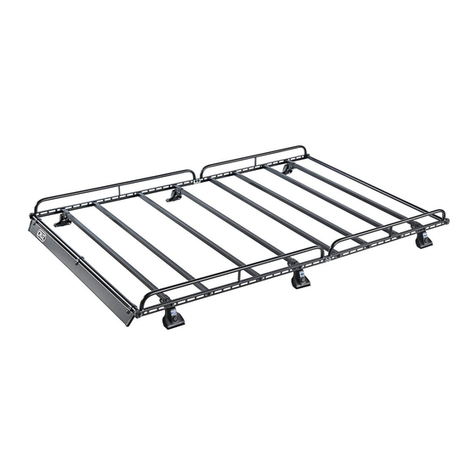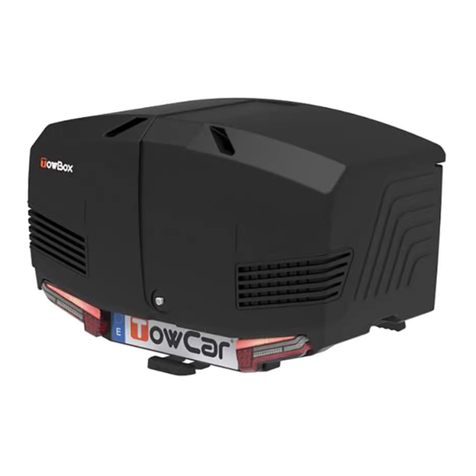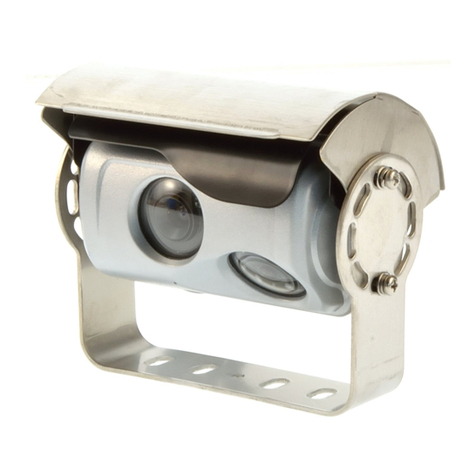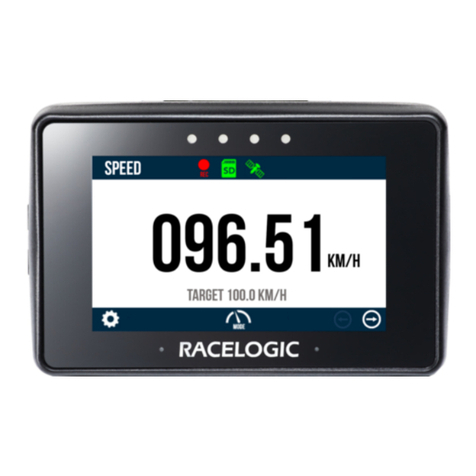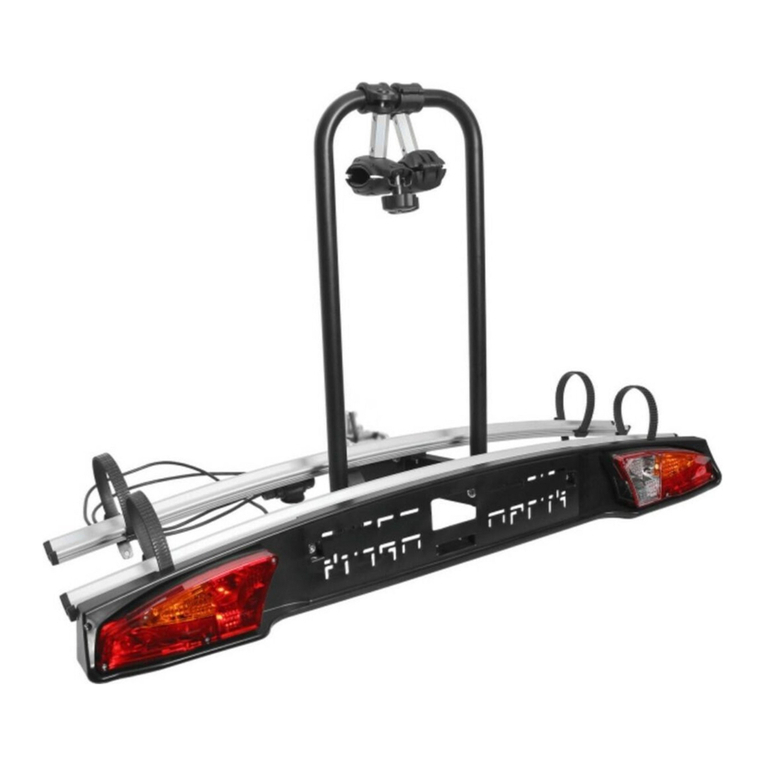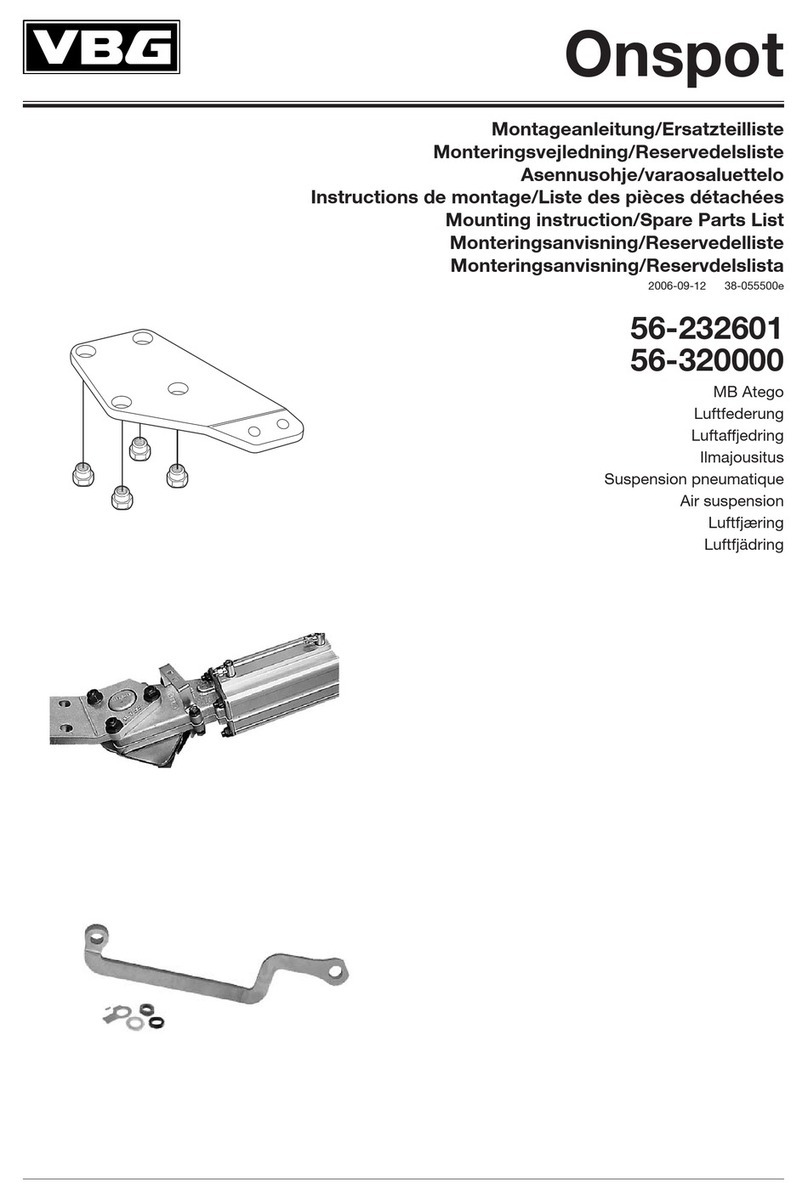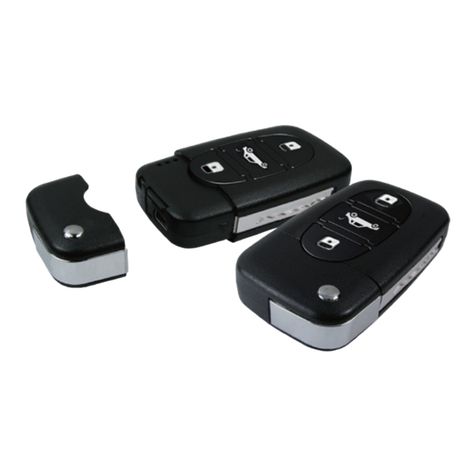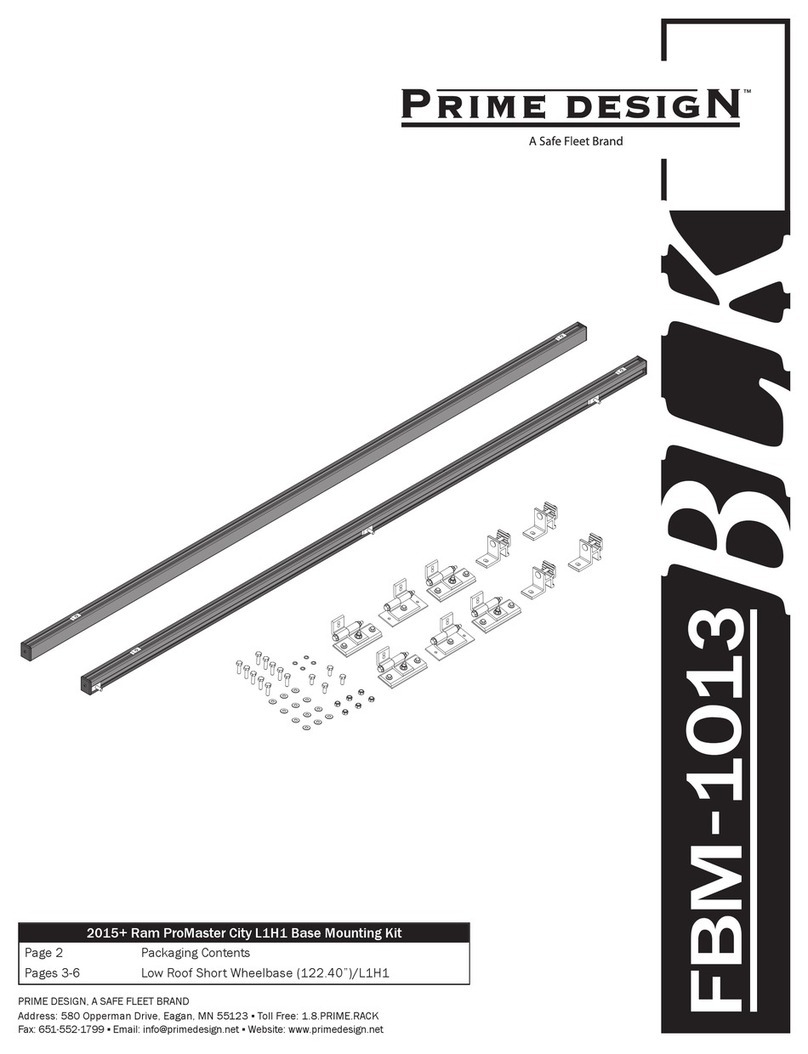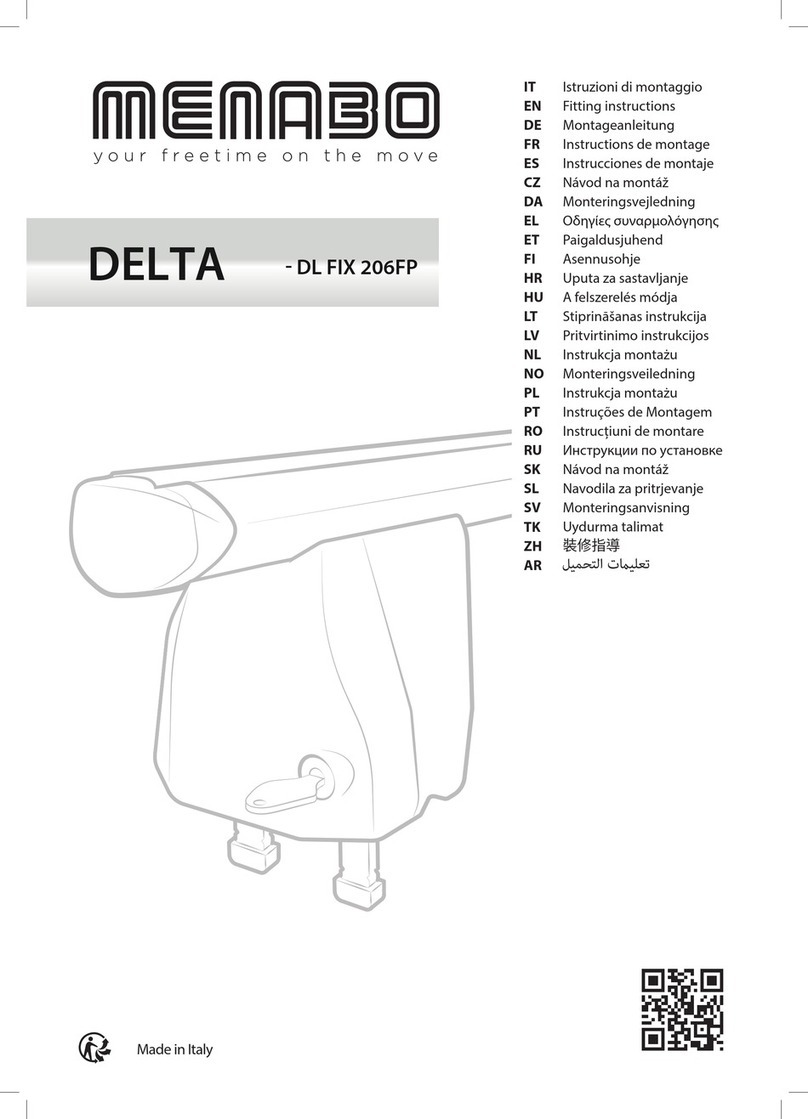TRUCKWRKS TT500000DS User manual

Service Body Trailer
Owner's Manual
Model TT500000DS
IN490500AV 10/09
© 2009
Register Now – Visit www.truckwrks.com


www.truckwrks.com
^ WARNING
This User’s Manual contains safety
information and instructions for your
trailer.
You must read this manual before
loading or towing your trailer.
You must follow all safety precautions
and instructions.

TABLE OF CONTENTS
- i -
1. GENERAL SAFETY INFORMATION .......................................................................................................................................3
1.1. Safety Alert Symbols and Signal Words.......................................................................................................................3
1.2. Major Hazards ..............................................................................................................................................................3
1.2.1. Improper Sizing of the Trailer to the Tow Vehicle.................................................................................................3
1.2.2. Driving Too Fast ...................................................................................................................................................4
1.2.3. Failure to Adjust Driving Behavior When Towing a Trailer...................................................................................4
1.2.4. Trailer Not Properly Coupled to the Hitch.............................................................................................................4
1.2.5. Proper Use of Safety Chains................................................................................................................................5
1.2.6. Proper Connection of Breakaway Brake...............................................................................................................5
1.2.7. Matching Trailer and Hitch....................................................................................................................................6
1.2.8. Worn Tires, Loose Wheels and Lug Nuts.............................................................................................................6
1.2.9. Improper Loading..................................................................................................................................................6
1.2.10. Unsafe Load Distribution ......................................................................................................................................7
1.2.11. Shifting Cargo.......................................................................................................................................................7
1.2.12. Inappropriate Cargo..............................................................................................................................................7
1.2.13. Inoperable Brakes, Lights or Mirrors.....................................................................................................................8
1.2.14. Hazards From Modifying Your Trailer...................................................................................................................8
1.2.15. Hazards From Accessories...................................................................................................................................8
1.2.15.1. Generator......................................................................................................................................................................8
1.2.16. Safety Warning Labels on Your Trailer...............................................................................................................10
1.3. Trailer Towing Guide ..................................................................................................................................................12
1.3.1. Safe Trailer Towing Guidelines...........................................................................................................................12
1.4. Reporting Safety Defects............................................................................................................................................13
2. TIRE SAFETY INFORMATION .............................................................................................................................................14
2.1. Steps for Determining Correct Load Limit – Trailer ....................................................................................................14
2.1.1. Trailers 10,000 Pounds GVWR or Less..............................................................................................................14
2.1.2. Trailers Over 10,000 Pounds GVWR..................................................................................................................14
2.2. Steps for Determining Correct Load Limit – Tow Vehicle...........................................................................................14
2.3. Glossary Of Tire Terminology.....................................................................................................................................15
2.4. Tire Safety - Everything Rides On It...........................................................................................................................17
2.4.1. Safety First–Basic Tire Maintenance..................................................................................................................17
2.4.2. Finding Your Vehicle's Recommended Tire Pressure and Load Limits..............................................................17
2.4.3. Understanding Tire Pressure and Load Limits ...................................................................................................17
2.4.4. Checking Tire Pressure......................................................................................................................................18
2.4.5. Steps for Maintaining Proper Tire Pressure........................................................................................................18
2.4.6. Tire Size..............................................................................................................................................................18
2.4.7. Tire Tread...........................................................................................................................................................18
2.4.8. Tire Balance and Wheel Alignment ....................................................................................................................18
2.4.9. Tire Repair..........................................................................................................................................................18
2.4.10. Tire Fundamentals..............................................................................................................................................19
2.4.10.1. Information on Passenger Vehicle Tires......................................................................................................................19
2.4.10.2. UTQGS Information ....................................................................................................................................................20
2.4.10.3. Additional Information on Light Truck Tires.................................................................................................................21
2.4.11. Tire Safety Tips...................................................................................................................................................21
3. COUPLING TO THE TOW VEHICLE ....................................................................................................................................22
3.1. Use an Adequate Tow Vehicle and Hitch...................................................................................................................22
3.1.1. Trailer Information...............................................................................................................................................22
3.1.2. Tow Vehicle Information.....................................................................................................................................23
3.2. Coupling and Uncoupling the Trailer ..........................................................................................................................23
3.2.1. Coupler...............................................................................................................................................................24
3.2.1.1. Before Coupling The Trailer To The Tow Vehicle............................................................................................................25
3.2.1.2. Prepare The Coupler And Hitch.......................................................................................................................................25
3.2.1.3. Couple The Trailer To The Tow Vehicle..........................................................................................................................25
3.2.2. Connect Safety Chains.......................................................................................................................................26
3.2.3. Connect The Electrical Cable.............................................................................................................................26
3.2.4. Attach And Test Electric Breakaway Brake System...........................................................................................27

TABLE OF CONTENTS
- ii -
3.2.5. Uncoupling The Trailer .......................................................................................................................................27
4. LOADING THE TRAILER.....................................................................................................................................................29
4.1. Load Capacities..........................................................................................................................................................29
4.2. Tongue Weight ...........................................................................................................................................................30
4.3. Checking Tongue Weight ...........................................................................................................................................31
4.4. Loading Cargo............................................................................................................................................................31
4.4.1.1. Preparing The Trailer For Loading...................................................................................................................................32
4.4.1.2. Loading The Trailer .........................................................................................................................................................32
4.5. Pre-tow Checklist........................................................................................................................................................33
4.6. Make Regular Stops...................................................................................................................................................33
5. BREAKING-IN A NEW TRAILER ..........................................................................................................................................34
5.1. Retighten Lug Nuts at First 10, 25 & 50 Miles............................................................................................................34
5.2. Adjust Brake Shoes at First 200 Miles........................................................................................................................34
5.3. Tire Pressure..............................................................................................................................................................34
6. FEATURES AND ACCESSORIES .........................................................................................................................................35
6.1. Standard Features......................................................................................................................................................35
6.1.1. Adjustable Shelves.............................................................................................................................................35
6.1.2. Stabilizer Jacks...................................................................................................................................................35
6.1.3. Cargo Door Auxiliary Locks................................................................................................................................36
6.2. Optional Accessories..................................................................................................................................................36
6.2.1. Generator............................................................................................................................................................36
6.2.2. Lockable Low Sliding Roof .................................................................................................................................37
6.2.3. Storage Rack......................................................................................................................................................37
6.2.4. Storage Tube......................................................................................................................................................38
6.2.5. Storage Drawer...................................................................................................................................................38
6.2.6. Awning................................................................................................................................................................39
7. INSPECTION, SERVICE & MAINTENANCE .........................................................................................................................40
7.1. Inspection, Service & Maintenance Summary Charts ................................................................................................40
7.2. Inspection and Service Instructions............................................................................................................................41
7.2.1. Axle Bolts, Frame, Suspension, & Structure ......................................................................................................41
7.2.2. Trailer Structure..................................................................................................................................................41
7.2.2.1. Cleaning ..........................................................................................................................................................................41
7.2.2.2. Fasteners and Frame Members ......................................................................................................................................41
7.2.2.3. Welds ..............................................................................................................................................................................41
7.2.3. Compartment Doors ...........................................................................................................................................41
7.2.3.1. Lubrication.......................................................................................................................................................................41
7.2.3.2. Striker Adjustment...........................................................................................................................................................42
7.2.4. Trailer Brakes .....................................................................................................................................................42
7.2.4.1. Brake Shoes and Drums..................................................................................................................................................42
7.2.4.2. Manually Adjusting Brake Shoes.....................................................................................................................................43
7.2.4.3. Electric Brakes.................................................................................................................................................................43
7.2.5. Trailer Connection to Tow Vehicle......................................................................................................................43
7.2.6. Landing Leg or Jack ...........................................................................................................................................44
7.2.7. Lights and Signals ..............................................................................................................................................44
7.2.8. Tires....................................................................................................................................................................44
7.2.9. Wheel Rims ........................................................................................................................................................44
7.2.10. Wheel Bearings ..................................................................................................................................................44
7.2.11. Wheel Lug Nuts..................................................................................................................................................45
7.3. Electrical Diagram.......................................................................................................................................................46
8. WARRANTY .........................................................................................................................................................................47

- 3 -
1. GENERAL SAFETY INFORMATION
1.1. SAFETY ALERT SYMBOLS AND SIGNAL
WORDS
An Owner’s Manual that provides general trailer information
cannot cover all of the specific details necessary for the
proper combination of every trailer, tow vehicle and hitch.
Therefore, you must read, understand and follow the
instructions given by the tow vehicle and trailer hitch
manufacturers, as well as the instructions in this manual.
TRUCKWRKS trailers are built with components produced
by various manufacturers. Some of these items have
separate instruction manuals. Where this manual indicates
that you should read another manual, and you do not have
that manual, call TruckWrks at 1-866-249-7737 or your
dealer for assistance.
The safety information in this manual is denoted by the
safety alert symbol: ^
The level of risk is indicated by the following signal words.
^ DANGER
DANGER – Immediate hazards which
WILL result in severe personal injury
or death if the warning is ignored.
^ WARNING
WARNING – Hazards or unsafe
practices which COULD result in
severe personal injury or death if the
warning is ignored.
^ CAUTION
CAUTION – Hazards or unsafe
practices which could result in minor
or moderate injury if the warning is
ignored.
NOTICE
NOTICE – Practices that could result
in damage to the trailer or other
property.
1.2. MAJOR HAZARDS
Loss of control of the trailer or trailer/tow vehicle
combination can result in death or serious injury. The most
common causes for loss of control of the trailer are:
•Improper sizing the trailer for the tow vehicle, or
vice versa.
•Excessive speed: Driving too fast for the
conditions.
•Failure to adjust driving behavior when towing a
trailer.
•Overloading and/or improper weight distribution.
•Improper or mis-coupling of the trailer to the
hitch.
•Improper braking and steering under sway
conditions.
•Not maintaining proper tire pressure.
•Not keeping lug nuts tight.
1.2.1. IMPROPER SIZING OF THE TRAILER TO THE TOW
VEHICLE
Trailers that weigh too much for the towing vehicle can
cause stability problems, which can lead to death or serious

GENERAL SAFETY INFORMATION
- 4 -
injury. Furthermore, the additional strain put on the engine
and drive-train may lead to serious tow vehicle maintenance
problems. For these reasons the maximum towing capacity
of your towing vehicle should not be exceeded. The towing
capacity of your tow vehicle, in terms of maximum Gross
Trailer Weight (GTW) and maximum Gross Combined
Weight Rating (GCWR) can be found in the tow vehicles
Owner’s Manual.
^ DANGER
Use of a tow vehicle with a towing
capacity less than the Gross Vehicle
Weight Rating of the trailer can result
in loss of control, and may lead to
death or serious injury.
Be sure your hitch and tow vehicle
are rated for the Gross Vehicle
Weight Rating of your trailer.
1.2.2. DRIVING TOO FAST
With ideal road conditions, the maximum recommended
speed for safely towing a trailer is 60 mph. If you drive too
fast, the trailer is more likely to sway, thus increasing the
possibility for loss of control. Also your tires may overheat,
thus increasing the possibility of a blowout.
^ WARNING
Driving too fast for conditions can
result in loss of control and cause
death or serious injury.
Decrease your speed when going
downhill or as road, weather, and
lighting conditions deteriorate.
1.2.3. FAILURE TO ADJUST DRIVING BEHAVIOR WHEN
TOWING A TRAILER
When towing a trailer, you will have decreased acceleration,
increased stopping distance, and increased turning radius
(which means you must make wider turns to keep from
hitting curbs, vehicles, and anything else that is on the
inside corner). Furthermore the trailer will change the
handling characteristics of your towing vehicle, making it
more sensitive to steering inputs and more likely to be
pushed around in windy conditions or when being passed by
large vehicles. In addition, you will need a longer distance to
pass, due to slower acceleration and increased length. With
these caveats in mind:
•Be alert for slippery conditions. You are more likely
to be affected by slippery road surfaces when
driving a tow vehicle with a trailer, than driving a tow
vehicle without a trailer.
•Anticipate the trailer “swaying.” Swaying can be
caused by excessive steering, wind gusts, roadway
edges, or by the trailer reaction to the pressure
wave created by passing trucks and busses.
•When encountering trailer sway take your foot off
the gas, and steer as little as possible in order to
stay on the road. Use small “trim-like” steering
adjustments. Do not attempt to steer out of the
sway; you’ll only make it worse. Also do not apply
the tow vehicle brakes to correct trailer swaying. On
the other hand, application of the trailer brakes
alone will tend to straighten out the combination,
especially when going downhill.
•Check rearview mirrors frequently to observe the
trailer and traffic.
•Use lower gear when driving down steep or long
grades. Use the engine and transmission as a
brake. Do not ride the brakes, as they can overheat
and become ineffective.
•Be aware of your trailer height, especially when
approaching bridges, roofed areas and around
trees.
1.2.4. TRAILER NOT PROPERLY COUPLED TO THE
HITCH
It is critical that the trailer be securely coupled to the hitch,
and that the safety chains and emergency breakaway brake
lanyard are correctly attached. Uncoupling may result in
death or serious injury to you and to others.

GENERAL SAFETY INFORMATION
- 5 -
^ WARNING
Proper selection and condition of the
coupler and hitch are essential to
safely towing your trailer. A loss of
coupling may result in death or
serious injury.
•Be sure the maximum load rating of
the hitch on the tow vehicle is
equal to or greater than the
maximum load rating of the
coupler on the trailer.
•Be sure the hitch ball size matches
the coupler size.
•Observe the hitch for wear,
corrosion and cracks before
coupling. Replace worn, corroded
or cracked hitch components before
coupling the trailer to the tow
vehicle.
•Be sure the hitch components are
tight before coupling the trailer to
the tow vehicle.
^ WARNING
An improperly coupled trailer can
result in death or serious injury.
Do not move the trailer until:
•The coupler is secured and locked
to hitch ball;
•The safety chains are secured to the
tow vehicle; and
•The trailer jacks are fully retracted.
Do not tow the trailer on the road
until:
•Tires and wheels are checked;
•The trailer brakes are checked;
•The breakaway lanyard is
connected to the tow vehicle;
•The load is secured to the trailer;
and
•The trailer lights are connected and
checked.
1.2.5. PROPER USE OF SAFETY CHAINS
If your trailer comes loose from the hitch for any reason, we
have provided safety chains so that control of the trailer can
still be maintained.
1.2.6. PROPER CONNECTION OF BREAKAWAY BRAKE
Your trailer is equipped with a breakaway brake system that
can apply the brakes on your trailer if your trailer comes
loose from the hitch for any reason. You will have a
separate set of instructions for the breakaway brake. The
breakaway brake system, including battery, must be in good
condition and properly rigged to be effective.
^ WARNING
An ineffective or inoperative
breakaway brake system can result in
a runaway trailer, leading to death
or serious injury, if the coupler or
hitch fails.
The breakaway lanyard must be
connected to the tow vehicle; and
NOT to any part of the hitch.
Before towing the trailer, test the
function of the breakaway brake
system. If the breakaway brake
system is not working, do not tow the
trailer; have it serviced or repaired.
^ WARNING
Improper rigging of the safety chains
can result in loss of control of the
trailer and tow vehicle, leading to
death or serious injury, if the trailer
uncouples from the tow vehicle.
•Fasten chains to frame of tow
vehicle. Do not fasten chains to
any part of the hitch unless the
hitch has holes or loops specifically
for that purpose.
•Cross chains underneath hitch and
coupler with enough slack to
permit turning and to hold tongue
up, if the trailer comes loose.

GENERAL SAFETY INFORMATION
- 6 -
1.2.7. MATCHING TRAILER AND HITCH
^ DANGER
Use of a hitch with a load rating less
than the load rating of the trailer can
result in loss of control and may lead
to death or serious injury.
1.2.8. WORN TIRES,LOOSE WHEELS AND LUG NUTS
Just as with your tow vehicle, the trailer tires and wheels are
important safety items. Therefore, it is essential to inspect
the trailer tires before each tow.
If a tire has a bald spot, bulge, cut, cracks, or is showing any
cords, replace the tire before towing. If a tire has uneven
tread wear, take the trailer to a dealer service center for
diagnosis. Uneven tread wear can be caused by tire
imbalance, axle misalignment or incorrect inflation.
Tires with too little tread will not provide adequate frictional
forces on wet roadways and can result in loss of control,
leading to death or serious injury.
Improper tire pressure causes increased tire wear and may
reduce trailer stability, which can result in a tire blowout or
possible loss of control. Therefore, before each tow you
must also check the tire pressure. Remember, the proper
tire pressure is listed on the Certification / VIN label,
normally mounted on front left side of the trailer, and should
be checked when tires are cold. Allow 3 hours cool-down
after driving as much as 1 mile at 40 mph before checking
tire pressure.
^ WARNING
Improper tire pressure can result in a
blowout and loss of control, which
can lead to death or serious injury.
Be sure tires are inflated to pressure
indicated on the Certification / VIN
label before towing trailer.
The tightness of the lug nuts is very important in keeping the
wheels properly seated to the hub. Before each tow, check
to make sure they are tightened to the proper torque.
^ WARNING
Metal creep between the wheel rim
and hub may cause lug nuts to loosen
and could result in a wheel coming
off, leading to death or serious injury.
Tighten lug nuts before each tow.
The proper tightness (torque) for lug nuts is listed in the
Inspection, Service and Maintenance section of this manual.
Use a torque wrench to tighten the lug nuts, use the
crisscross star pattern.
Lug nuts are also prone to loosen after first being
assembled. When driving a new trailer (or after wheels
have been remounted), check to make sure they are tight
after the first 10, 25 and 50 miles of driving and before each
tow thereafter.
Failure to perform this check can result in a wheel
separating from the trailer and a crash, leading to death or
serious injury.
^ WARNING
Lug nuts are prone to loosen after
initial installation, which can lead to
death or serious injury.
Check lug nuts for tightness on a new
trailer or when wheel(s) have been
remounted after the first 10, 25 and
50 miles of driving.
^ WARNING
Improper lug nut torque can cause a
wheel separating from the trailer,
leading to death or serious injury.
Be sure lug nuts are tight before each
tow.
1.2.9. IMPROPER LOADING
The total weight of the load you put in or on the trailer, plus
the empty weight of the trailer itself, must not exceed the
trailer's Gross Vehicle Weight Rating (GVWR). If you do not
know the empty weight of the trailer plus the cargo weight,
you must weigh the loaded trailer at a commercial scale. In
addition, you must distribute the load in the trailer such that
the load on any axle does not exceed the Gross Axle Weight
Rating (GAWR). If your trailer is equipped with a Tire &

GENERAL SAFETY INFORMATION
- 7 -
Loading Information Placard, mounted next to the
Certification / VIN label, the cargo capacity weight stated on
that placard is only a close estimate. The GVWR and
GAWR’s are listed on the Certification / VIN label mounted
on the front left side of the trailer.
^ WARNING
An overloaded trailer can result in
loss of control of the trailer, leading
to death or serious injury.
Do not exceed the trailer Gross
Vehicle Weight Rating (GVWR) or an
axle Gross Axle Weight Rating
(GAWR).
Do not load a trailer so that the
weight on any tire exceeds its rating.
1.2.10.UNSAFE LOAD DISTRIBUTION
Improper front / rear load distribution can lead to poor trailer
sway stability or poor tow vehicle handling. Poor trailer sway
stability results from tongue weights that are too low, and
poor tow vehicle stability results from tongue weights that
are too high. Refer to the Loading the Trailer section for
more information.
The rule of thumb is 6-10% percent of total weight of the
trailer and its cargo (Gross Trailer Weight, or “GTW”) should
be on the tongue of the trailer. For example, a trailer with a
loaded weight of 7,000 pounds should have 6-10% of 7,000
pounds (420-700 lbs.) on the hitch.
After loading, be sure to check that none of the axles are
overloaded.
Uneven left / right load distribution can cause tire, wheel,
axle or structural failure. Be sure your trailer is evenly
loaded left / right. Towing stability also depends on keeping
the center of gravity as low as possible.
^ WARNING
Improper tongue weight (load
distribution) can result in loss of
control of the trailer, leading to death
or serious injury.
Make certain that tongue weight is
within the allowable range.
Be sure to:
•Distribute the load front-to-rear to
provide proper tongue weight (see
chart).
•Distribute the load evenly, right
and left.
•Keep the center of gravity low.
1.2.11.SHIFTING CARGO
Since the trailer “ride” can be bumpy and rough, you must
secure your cargo so that it does not shift while the trailer is
being towed.
^ WARNING
Shifting cargo can result in loss of
control of the trailer, and can lead to
death or serious injury.
Tie down all loads with proper sized
fasteners, ropes, straps, etc.
Verify that the doors are closed and properly latched.
^ WARNING
If the door opens, your cargo may be
ejected onto the road, resulting in
death or serious injury to other
drivers.
Verify that the doors are properly
closed and latched.
1.2.12.INAPPROPRIATE CARGO
Your trailer must not be used to carry certain items, such as
people, containers of hazardous substances or containers of
flammable substances.

GENERAL SAFETY INFORMATION
- 8 -
^ WARNING
Do not transport people inside the
trailer.
The transport of people puts their
lives at risk and is illegal.
^ WARNING
Do not transport flammable,
explosive, poisonous or other
dangerous materials in your trailer.
The exception is fuel stored in the
tank of equipment being hauled.
1.2.13.INOPERABLE BRAKES,LIGHTS OR MIRRORS
Be sure that the electric brakes and all of the lights on your
trailer are functioning properly before towing your trailer.
Electric brakes and lights on a trailer are controlled via a
connection to the tow vehicle, generally a multi-pin electrical
connector. Check the trailer tail lights by turning on your tow
vehicle headlights. Check the trailer brake lights by having
someone step on the tow vehicle brake pedal while you look
at trailer lights. Do the same thing to check the turn signal
lights.
Your tow vehicle will have an electric brake controller that
sends power to the trailer brakes. Before towing the trailer
on the road, you must operate the brake controller while
trying to pull the trailer in order to confirm that the electric
brakes operate. While towing the trailer at less than 5 mph,
manually operate the electric brake controller in the tow
vehicle cab. You should feel the operation of the trailer
brakes.
^ WARNING
Improper electrical connection
between the tow vehicle and the
trailer will result in inoperable lights
and electric brakes, and can lead to
collision.
Before each tow:
•Check that the taillights, brake
lights and turn signals work
•Check that the electric brakes work
by operating the brake controller
inside the tow vehicle
Standard mirrors usually do not provide adequate visibility
for viewing traffic to the sides and rear a towed trailer. You
must provide mirrors that allow you to safely observe
approaching traffic.
1.2.14.HAZARDS FROM MODIFYING YOUR TRAILER
Essential safety items can be damaged by altering your
trailer. Even simply driving a nail or screw to hang
something can damage an electrical circuit, structural frame
member or other feature of the trailer.
Before making any alteration to your trailer, contact your
dealer or TruckWrks at Error! Reference source not
found. and describe the alteration you are contemplating.
Alteration or modification of the trailer may void the
warranty. Alteration or modification of the trailer structure
must be performed only by qualified technicians with the
written permission from TRUCKWRKS.
1.2.15.HAZARDS FROM ACCESSORIES
The “Features and Accessories” chapter of this manual contains
some information about certain optional accessories that
may be on your trailer. Read and follow all of these
instructions before operating the accessories. The major
hazards from some of these accessories are:
1.2.15.1. Generator
If your trailer is equipped with a generator, you must have
and follow the generator manufacturer’s instructions. You
must also have one or more carbon monoxide detectors on
the interior of the trailer.
Carbon Monoxide is an odorless gas that can cause death.
Be certain exhaust from a running generator does not
accumulate in or around your trailer, by situations such as:
•Being drawn in by fans or ventilators operated
in a trailer;
•Prevailing wind;
•Being trapped between your trailer and other
trailers, vehicles or buildings; or
•Being trapped between your trailer and, or in a
snow bank, or other nearby objects

GENERAL SAFETY INFORMATION
- 9 -
^ WARNING
Operating gasoline and diesel
generators can lead to death or
serious injury by:
•Carbon Monoxide
•Fire and Explosion
•Electrocution
Have a working carbon monoxide
detector inside the trailer before
operating a generator.
Do not refuel a running generator or
refuel near ignition sources.
See the Features and Accessories section for more detailed
information.

GENERAL SAFETY INFORMATION
10
1.2.16.SAFETY WARNING LABELS ON YOUR TRAILER
Figure 1-2 – Located On Coupler
Figure 1-3 – Located On Tool Box
Figure 1-1 – Located On Left Side Of Hitch

GENERAL SAFETY INFORMATION
- 11 -
Figure 1-4 – Located On Left Side Of Hitch
Figure 1-5 – Located On Left Side Of Hitch
Figure 1-6 – Located On Tool Box

GENERAL SAFETY INFORMATION
- 12 -
^ WARNING
To protect you and others against
death or serious injury, all of the
labels shown must be on the trailer
and must be legible.
If any of these labels are missing or
cannot be read, call Error! Reference
source not found. at 800-277-8245 or
your dealer for replacement labels.
You will need to provide us with the
number shown at the bottom of the
label(s) in order for us to send the
correct one(s).
1.3. TRAILER TOWING GUIDE
Driving a vehicle with a trailer in tow is vastly different from
driving the same vehicle without a trailer in tow.
Acceleration, maneuverability and braking are all diminished
with a trailer in tow. It takes longer to get up to speed; you
need more room to turn and pass, and more distance to
stop when towing a trailer. You will need to spend time
adjusting to the different feel and maneuverability of the tow
vehicle with a trailer. Because of the significant differences
in all aspects of maneuverability when towing a trailer, the
hazards and risks of injury are also much greater than when
driving without a trailer. You are responsible for keeping
your vehicle and trailer in control, and for all the damage
that is caused if you lose control of your vehicle and trailer.
As you did when learning to drive an automobile, find an
open area with little or no traffic for your first practice towing.
Of course, before you start towing the trailer, you must
follow all of the instructions for inspection, testing, loading
and coupling. Also, before you start towing, adjust the
mirrors so you can see the trailer as well as the area to the
rear of it.
Drive slowly at first, 5 mph or so, and turn the wheel to get
the feel of how the tow vehicle and trailer combination
responds. Next, make some right and left hand turns.
Watch in your side mirrors to see how the trailer follows the
tow vehicle. Turning with a trailer attached requires more
room.
Stop the rig a few times from speeds no greater than 10
mph. If your trailer is equipped with brakes, try using
different combinations of trailer/electric brake and tow
vehicle brake. Note the effect that the trailer brakes have
when they are the only brakes used. When properly
adjusted, the trailer brakes will come on just before the tow
vehicle brakes.
It will take practice to learn how to back up a tow vehicle
with a trailer attached. Take it slow. Before backing up, get
out of the tow vehicle and look behind the trailer to make
sure that there are no obstacles. Some drivers place their
hands at the bottom of the steering wheel, and while the tow
vehicle is in reverse, “think” of the hands as being on the top
of the wheel. When the hands move to the right (counter-
clockwise, as you would do to turn the tow vehicle to the left
when moving forward), the rear of the trailer moves to the
right. Conversely, rotating the steering wheel clockwise with
your hands at the bottom of the wheel will move the rear of
the trailer to the left, while backing up. If you are towing a
bumper hitch rig, be careful not to allow the trailer to turn too
much, because it will hit the rear of the tow vehicle. To
straighten the rig, either pull forward, or turn the steering
wheel in the opposite direction.
1.3.1. SAFE TRAILER TOWING GUIDELINES
•Recheck the load tie downs to make sure the load
will not shift during towing.
•Before towing, check coupling, safety chains,
breakaway brake, tires, wheels and lights.
•Check the lug nuts for proper tightness.
•Check coupler tightness after towing 50 miles.
•Adjust the brake controller to engage the trailer
brakes before the tow vehicle brakes. Follow the
instructions given with the brake controller
manufacturer’s literature.
•Use your mirrors to verify that you have room to
change lanes or pull into traffic.
•Use your turn signals well in advance.
•Allow plenty of stopping space for your trailer and
tow vehicle.
•Do not drive so fast that the trailer begins to sway
due to speed. Generally never drive faster than 60
m.p.h.
•Allow plenty of room for passing. A rule of thumb is
that the passing distance with a trailer is 4 times the
passing distance without a trailer.
•Use lower gears for climbing and descending
grades.

GENERAL SAFETY INFORMATION
- 13 -
•Do not ride the brakes while descending grades;
they may get so hot that they stop working, then you
will potentially have a runaway tow vehicle and
trailer.
•To conserve fuel, don't use full throttle to climb a
hill. Instead, build speed on the approach.
•Slow down for bumps in the road. Take your foot off
the brake when crossing the bump.
•Do not brake while in a curve unless absolutely
necessary. Instead, slow down before you enter the
curve.
•Do not apply the tow vehicle brakes to correct
extreme trailer swaying. Instead, lightly apply the
trailer brakes with the hand controller.
•Make regular stops, about once each hour. Confirm
that:
•The coupler is secure to the hitch and is locked,
•Electrical connections are made,
•There is appropriate slack in the safety chains,
•There is appropriate slack in the breakaway
lanyard,
•The tires are not visibly low on pressure, and
•The cargo is secure and in good condition.
1.4. REPORTING SAFETY DEFECTS
If you believe that your vehicle has a defect that could cause
a crash or could cause injury or death, you should
immediately inform the National Highway Traffic Safety
Administration (NHTSA) in addition to notifying TruckWrks.
If NHTSA receives similar complaints, it may open an
investigation, and if it finds that a safety defect exists in a
group of vehicles, it may order a recall and remedy
campaign. However, NHTSA cannot become involved in
individual problems between you, your dealer, or
TruckWrks.
To contact NHTSA, you may either call the Vehicle Safety
Hotline toll-free at 1-888-327-4236 (TTY: 1-800-424-9153),
go tohttp://www.safecar.gov; or write to: Administrator,
NHTSA1200 New jersey Avenue, SW., Washington, DC
20590. You can also obtain other information about motor
vehicle safety from http://www.safercar.gov.

14
2. TIRE SAFETY INFORMATION
This portion of the User’s Manual contains tire safety
information as required by 49 CFR 575.6.
Section 2.1 contains “Steps for Determining Correct Load
Limit - Trailer”.
Section 2.2 contains “Steps for Determining Correct Load
Limit – Tow Vehicle”.
Section 2.3 contains a Glossary of Tire Terminology,
including “cold inflation pressure”, “maximum inflation
pressure”, “recommended inflation pressure”, and other non-
technical terms.
Section 2.4 contains information from the NHTSA brochure
entitled “Tire Safety – Everything Rides On It”.
This brochure describes the following items;
•Tire labeling, including a description and
explanation of each marking on the tires, and
information about the DOT Tire Identification
Number (TIN).
•Recommended tire inflation pressure, including a
description and explanation of:
A. Cold inflation pressure.
B. Vehicle Placard and location on the vehicle.
C. Adverse safety consequences of under inflation
(including tire failure).
D. Measuring and adjusting air pressure for proper
inflation.
•Tire Care, including maintenance and safety
practices.
•Vehicle load limits, including a description and
explanation of the following items:
A. Locating and understanding the load limit
information, total load capacity, and cargo
capacity.
B. Calculating total and cargo capacities with
varying seating configurations including
quantitative examples showing / illustrating how
the vehicles cargo and luggage capacity
decreases as combined number and size of
occupants’ increases. This item is also
discussed in Section 3.
C. Determining compatibility of tire and vehicle load
capabilities.
D. Adverse safety consequences of overloading on
handling and stopping on tires.
2.1. STEPS FOR DETERMINING CORRECT LOAD
LIMIT –TRAILER
2.1.1. TRAILERS 10,000 POUNDS GVWR OR LESS
Figure 2-1 - Tire and Loading Placard
1. Locate the statement, “The weight of cargo should
never exceed XXX kg or XXX lbs.,” on your vehicle’s
placard. See figure 2-1.
2. This figure equals the available amount of cargo and
luggage load capacity.
3. Determine the combined weight of luggage and cargo
being loaded on the vehicle. That weight may not safely
exceed the available cargo and luggage load capacity.
The trailer’s placard refers to the Tire Information Placard
attached adjacent to or near the trailer’s VIN (Certification)
label on the left front of the trailer.
2.1.2. TRAILERS OVER 10,000 POUNDS GVWR
Note: These trailers are not required to have a tire
information placard on the vehicle.
1. Determine the empty weight of your trailer by weighing
the trailer using a public scale or other means. This
step does not have to be repeated.
2. Locate the GVWR (Gross Vehicle Weight Rating) of the
trailer on your trailer’s VIN (Certification) label.
3. Subtract the empty weight of your trailer from the
GVWR stated on the VIN label. That weight is the
maximum available cargo capacity of the trailer and may
not be safely exceeded.
2.2. STEPS FOR DETERMINING CORRECT LOAD
LIMIT –TOW VEHICLE
1. Locate the statement, “The combined weight of
occupants and cargo should never exceed XXX lbs.,” on
your vehicle’s placard.
2. Determine the combined weight of the driver and
passengers who will be riding in your vehicle.
3. Subtract the combined weight of the driver and
passengers from XXX kilograms or XXX pounds.

TIRE SAFETY INFORMATION
- 15 -
4. The resulting figure equals the available amount of
cargo and luggage capacity. For example, if the “XXX”
amount equals 1400 lbs. and there will be five 150 lb.
passengers in your vehicle, the amount of available
cargo and luggage capacity is 650 lbs. (1400-750 (5 x
150) = 650 lbs.).
5. Determine the combined weight of luggage and cargo
being loaded on the vehicle. That weight may not safely
exceed the available cargo and luggage capacity
calculated in Step # 4.
6. If your vehicle will be towing a trailer, load from your
trailer will be transferred to your vehicle. Consult the tow
vehicle’s manual to determine how this weight transfer
reduces the available cargo and luggage capacity of
your vehicle.
2.3. GLOSSARY OF TIRE TERMINOLOGY
Accessory weight
The combined weight (in excess of those standard items
which may be replaced) of automatic transmission, power
steering, power brakes, power windows, power seats, radio
and heater, to the extent that these items are available as
factory-installed equipment (whether installed or not).
Bead
The part of the tire that is made of steel wires, wrapped or
reinforced by ply cords and that is shaped to fit the rim.
Bead separation
This is the breakdown of the bond between components in
the bead.
Bias ply tire
A pneumatic tire in which the ply cords that extend to the
beads are laid at alternate angles substantially less than 90
degrees to the centerline of the tread.
Carcass
The tire structure, except tread and sidewall rubber which,
when inflated, bears the load.
Chunking
The breaking away of pieces of the tread or sidewall.
Cold inflation pressure
The pressure in the tire before you drive.
Cord
The strands forming the plies in the tire.
Cord separation
The parting of cords from adjacent rubber compounds.
Cracking
Any parting within the tread, sidewall, or inner liner of the tire
extending to cord material.
CT
A pneumatic tire with an inverted flange tire and rim system
in which the rim is designed with rim flanges pointed radially
inward and the tire is designed to fit on the underside of the
rim in a manner that encloses the rim flanges inside the air
cavity of the tire.
Curb weight
The weight of a motor vehicle with standard equipment
including the maximum capacity of fuel, oil, and coolant,
and, if so equipped, air conditioning and additional weight
optional engine.
Extra load tire
A tire designed to operate at higher loads and at higher
inflation pressures than the corresponding standard tire.
Groove
The space between two adjacent tread ribs.
Innerliner
The layer(s) forming the inside surface of a tubeless tire that
contains the inflating medium within the tire.
Innerliner separation
The parting of the innerliner from cord material in the
carcass.
Intended outboard sidewall
The sidewall that contains a white-wall, bears white lettering
or bears manufacturer, brand, and/or model name molding
that is higher or deeper than the same molding on the other
sidewall of the tire or the outward facing sidewall of an
asymmetrical tire that has a particular side that must always
face outward when mounted on a vehicle.
Light truck (LT) tire
A tire designated by its manufacturer as primarily intended
for use on lightweight trucks or multipurpose passenger
vehicles.
Load rating
The maximum load that a tire is rated to carry for a given
inflation pressure.
Maximum load rating
The load rating for a tire at the maximum permissible
inflation pressure for that tire.
Maximum permissible inflation pressure
The maximum cold inflation pressure to which a tire may be
inflated.
Maximum loaded vehicle weight
The sum of curb weight, accessory weight, vehicle capacity
weight, and production options weight.
Measuring rim
The rim on which a tire is fitted for physical dimension
requirements.

TIRE SAFETY INFORMATION
- 16 -
Non-pneumatic rim
A mechanical device which, when a non-pneumatic tire
assembly incorporates a wheel, supports the tire, and
attaches, either integrally or separably, to the wheel center
member and upon which the tire is attached.
Non-pneumatic spare tire assembly
A non-pneumatic tire assembly intended for temporary use
in place of one of the pneumatic tires and rims that are fitted
to a passenger car in compliance with the requirements of
this standard.
Non-pneumatic tire
A mechanical device which transmits, either directly or
through a wheel or wheel center member, the vertical load
and tractive forces from the roadway to the vehicle,
generates the tractive forces that provide the directional
control of the vehicle and does not rely on the containment
of any gas or fluid for providing those functions.
Non-pneumatic tire assembly
A non-pneumatic tire, alone or in combination with a wheel
or wheel center member, which can be mounted on a
vehicle.
Normal occupant weight
This means 68 kilograms (150 lbs.) times the number of
occupants specified in the second column of Table I of 49
CFR 571.110.
Occupant distribution
The distribution of occupants in a vehicle as specified in the
third column of Table I of 49 CFR 571.110.
Open splice
Any parting at any junction of tread, sidewall, or innerliner
that extends to cord material.
Outer diameter
The overall diameter of an inflated new tire.
Overall width
The linear distance between the exteriors of the sidewalls of
an inflated tire, including elevations due to labeling,
decorations, or protective bands or ribs.
Ply
A layer of rubber-coated parallel cords.
Ply separation
A parting of rubber compound between adjacent plies.
Pneumatic tire
A mechanical device made of rubber, chemicals, fabric and
steel or other materials, that, when mounted on an
automotive wheel, provides the traction and contains the
gas or fluid that sustains the load.
Production options weight
The combined weight of those installed regular production
options weighing over 2.3 kilograms (5 lbs.) in excess of
those standard items which they replace, not previously
considered in curb weight or accessory weight, including
heavy duty brakes, ride levelers, cargo rack, heavy duty
battery, and special trim.
Radial ply tire
A pneumatic tire in which the ply cords that extend to the
beads are laid at substantially 90 degrees to the centerline
of the tread.
Recommended inflation pressure
This is the inflation pressure provided by the vehicle
manufacturer on the Tire Information label and on the
Certification / VIN tag.
Reinforced tire
A tire designed to operate at higher loads and at higher
inflation pressures than the corresponding standard tire.
Rim
A metal support for a tire or a tire and tube assembly upon
which the tire beads are seated.
Rim diameter
This means the nominal diameter of the bead seat.
Rim size designation
This means the rim diameter and width.
Rim type designation
This means the industry of manufacturer’s designation for a
rim by style or code.
Rim width
This means the nominal distance between rim flanges.
Section width
The linear distance between the exteriors of the sidewalls of
an inflated tire, excluding elevations due to labeling,
decoration, or protective bands.
Sidewall
That portion of a tire between the tread and bead.
Sidewall separation
The parting of the rubber compound from the cord material
in the sidewall.
Special Trailer (ST) tire
The "ST" is an indication the tire is for trailer use only.
Test rim
The rim on which a tire is fitted for testing, and may be any
rim listed as appropriate for use with that tire.
Tread
That portion of a tire that comes into contact with the road.

TIRE SAFETY INFORMATION
- 17 -
Tread rib
A tread section running circumferentially around a tire.
Tread separation
Pulling away of the tread from the tire carcass.
Treadwear indicators (TWI)
The projections within the principal grooves designed to give
a visual indication of the degrees of wear of the tread.
Vehicle capacity weight
The rated cargo and luggage load plus 68 kilograms (150
lbs.) times the vehicle’s designated seating capacity.
Vehicle maximum load on the tire
The load on an individual tire that is determined by
distributing to each axle its share of the maximum loaded
vehicle weight and dividing by two.
Vehicle normal load on the tire
The load on an individual tire that is determined by
distributing to each axle its share of the curb weight,
accessory weight, and normal occupant weight (distributed
in accordance with Table I of CRF 49 571.110) and dividing
by 2.
Weather side
The surface area of the rim not covered by the inflated tire.
Wheel center member
In the case of a non-pneumatic tire assembly incorporating a
wheel, a mechanical device which attaches, either integrally
or separably, to the non-pneumatic rim and provides the
connection between the non-pneumatic rim and the vehicle;
or, in the case of a non-pneumatic tire assembly not
incorporating a wheel, a mechanical device which attaches,
either integrally or separably, to the non-pneumatic tire and
provides the connection between tire and the vehicle.
Wheel-holding fixture
The fixture used to hold the wheel and tire assembly
securely during testing.
2.4. TIRE SAFETY -EVERYTHING RIDES ON IT
The National Traffic Safety Administration (NHTSA) has
published a brochure (DOT HS 809 361) that discusses all
aspects of Tire Safety, as required by CFR 575.6. This
brochure is reproduced in part below. It can be obtained
and downloaded from NHTSA, free of charge, from the
following web site:
http://www.nhtsa.dot.gov/cars/rules/TireSafety/ridesonit/tires
_index.html
Studies of tire safety show that maintaining proper tire
pressure, observing tire and vehicle load limits (not carrying
more weight in your vehicle than your tires or vehicle can
safely handle), avoiding road hazards, and inspecting tires
for cuts, slashes, and other irregularities are the most
important things you can do to avoid tire failure, such as
tread separation or blowout and flat tires. These actions,
along with other care and maintenance activities, can also:
•Improve vehicle handling
•Help protect you and others from avoidable breakdowns
and accidents
•Improve fuel economy
•Increase the life of your tires.
This booklet presents a comprehensive overview of tire
safety, including information on the following topics:
•Basic tire maintenance
•Uniform Tire Quality Grading System
•Fundamental characteristics of tires
•Tire safety tips.
Use this information to make tire safety a regular part of
your vehicle maintenance routine. Recognize that the time
you spend is minimal compared with the inconvenience and
safety consequences of a flat tire or other tire failure.
2.4.1. SAFETY FIRST–BASIC TIRE MAINTENANCE
Properly maintained tires improve the steering, stopping,
traction, and load-carrying capability of your vehicle.
Underinflated tires and overloaded vehicles are a major
cause of tire failure. Therefore, as mentioned above, to
avoid flat tires and other types of tire failure, you should
maintain proper tire pressure, observe tire and vehicle load
limits, avoid road hazards, and regularly inspect your tires.
2.4.2. FINDING YOUR VEHICLE'S RECOMMENDED TIRE
PRESSURE AND LOAD LIMITS
Tire information placards and vehicle certification labels
contain information on tires and load limits. These labels
indicate the vehicle manufacturer's information including:
•Recommended tire size
•Recommended tire inflation pressure
•Vehicle capacity weight (VCW–the maximum occupant
and cargo weight a vehicle is designed to carry)
•Front and rear gross axle weight ratings (GAWR– the
maximum weight the axle systems are designed to
carry).
Both placards and certification labels are permanently
attached to the trailer near the left front.
2.4.3. UNDERSTANDING TIRE PRESSURE AND LOAD
LIMITS
Tire inflation pressure is the level of air in the tire that
provides it with load-carrying capacity and affects the overall
performance of the vehicle. The tire inflation pressure is a
number that indicates the amount of air pressure– measured
in pounds per square inch (psi)–a tire requires to be properly
inflated. (You will also find this number on the vehicle
Table of contents
Popular Automobile Accessories manuals by other brands
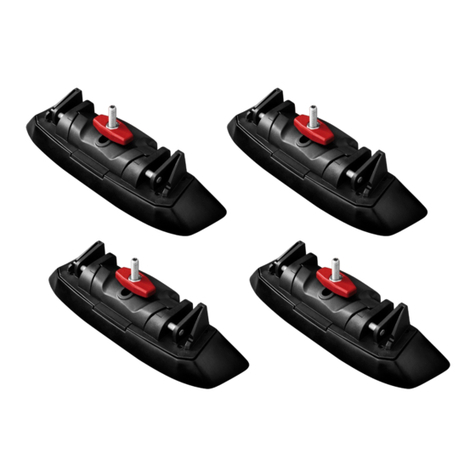
Whispbar
Whispbar K800W Fitting Instructions for Basic Carrier
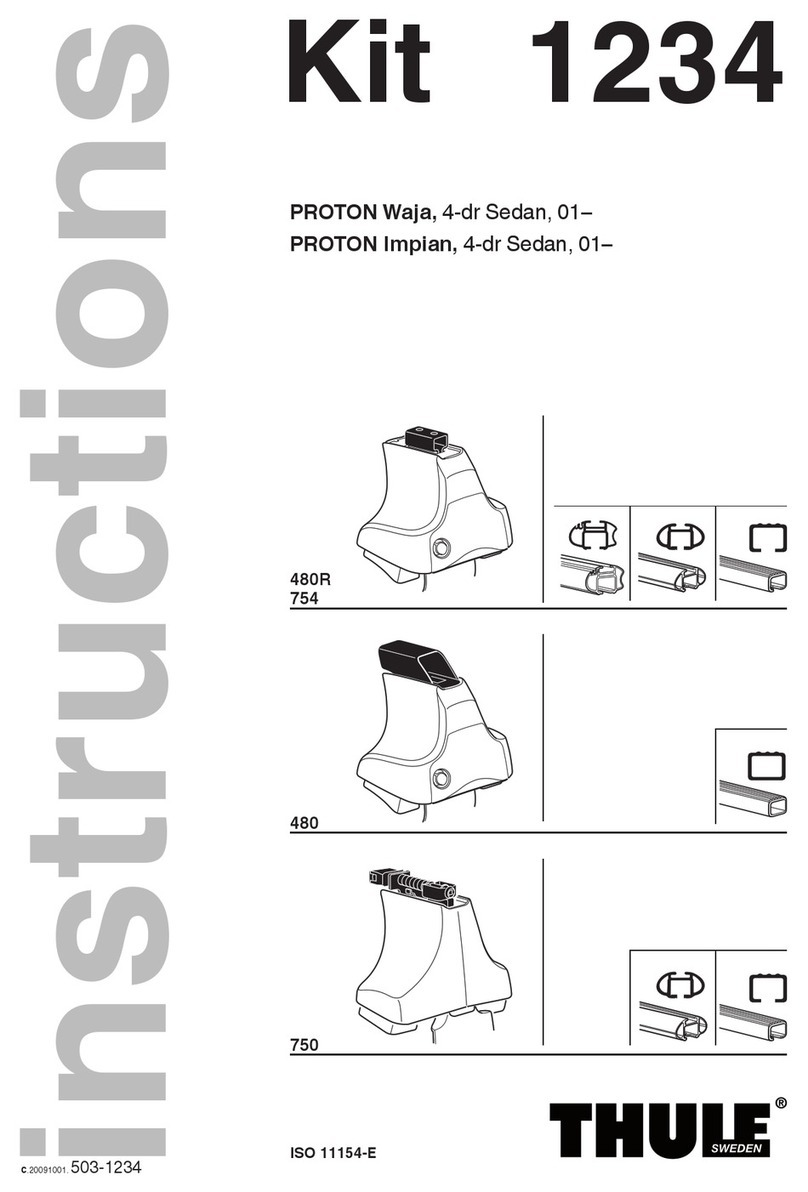
Thule
Thule 1234 instructions

Menabo
Menabo MISTRAL Fitting instructions
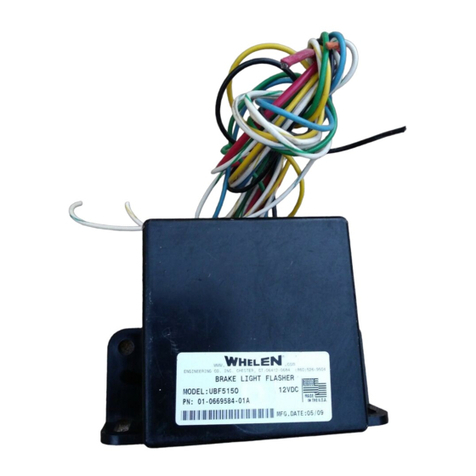
Whelen Engineering Company
Whelen Engineering Company UBF5150 installation guide
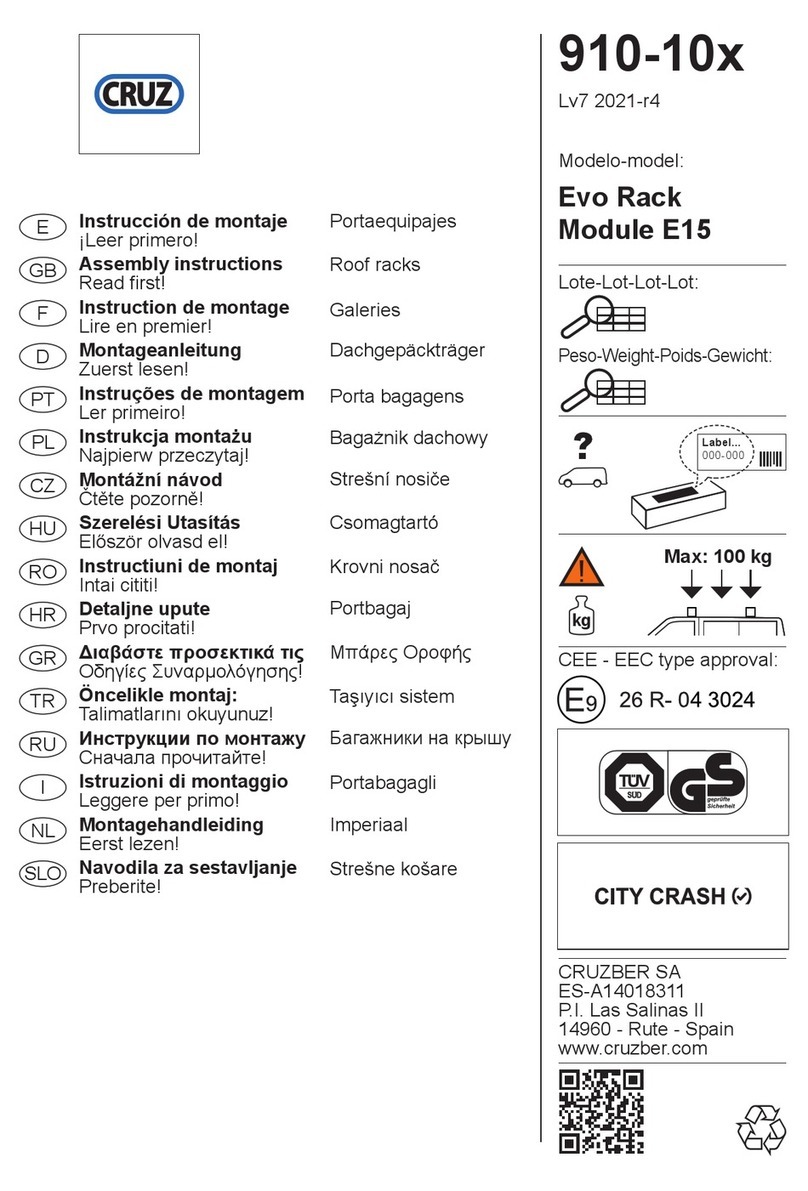
Cruz
Cruz Evo Rack Module E15 Assembly instructions
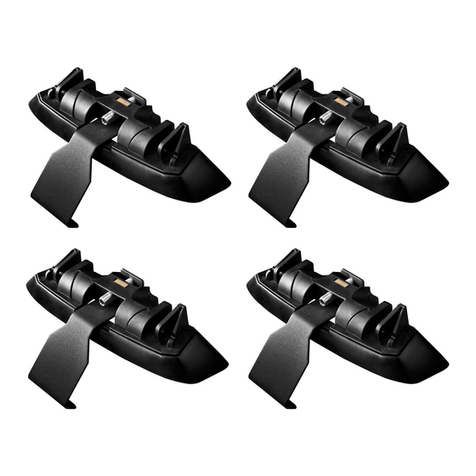
Whispbar
Whispbar K541W Fitting instructions
